


How Do Foam Pump Bottle Work?
Views: 0 Author: Site Editor Publish Time: 2025-07-10 Origin: Site








Ever wondered how foam pump bottles create that perfect foam every time? These handy dispensers are more than just a convenience.
In this article, we’ll dive into how foam pump bottles work and their importance across various industries. You’ll learn about their materials, mechanisms, and why they are so widely used in cosmetics, household products, and beyond.
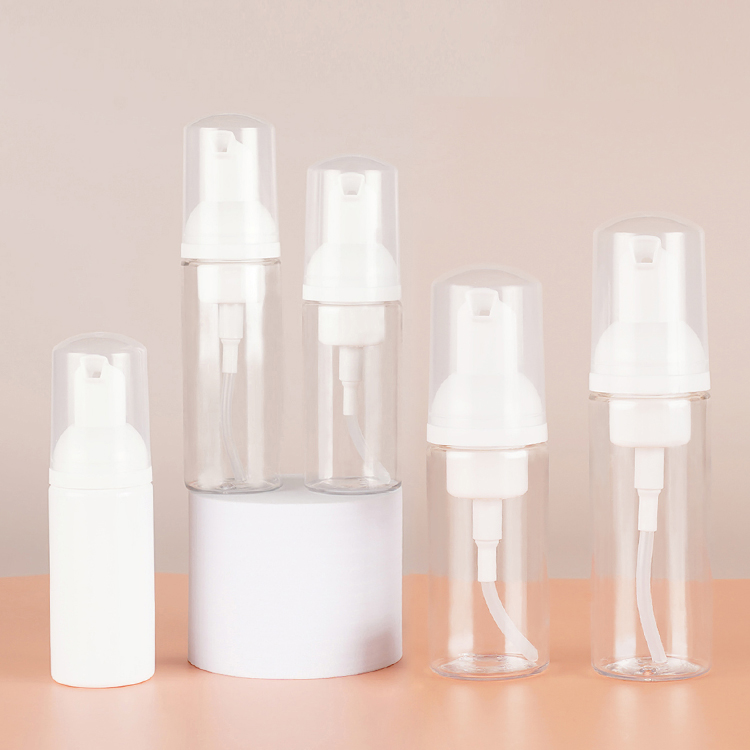
What is a Foam Pump Bottle?
A foam pump bottle is a unique dispenser that creates foam from liquid products, such as soaps, lotions, and shampoos. It uses a pump mechanism that mixes air and liquid to create a foamy texture, making it easier to apply and reducing product wastage.
Components of a Foam Pump Bottle
● Bottle Body: Typically made from PET or HDPE, the bottle is clear, sturdy, and recyclable.
● Pump: The heart of the mechanism, often made from PP or ABS, allows for easy dispensing.
● Nozzle: Dispenses the foam in a controlled, consistent manner.
The Air-Liquid Mixing Mechanism
The key to a foam pump bottle is its ability to mix air with liquid. When the pump is pressed, air enters the chamber, combining with the liquid inside. This creates a foam, which is then pushed out through the nozzle. This process ensures a consistent texture each time, making the foam ideal for products like hand soap or face wash.
Variations of Foam Pump Bottles
Foam pump bottles come in different sizes, from small 50ml bottles for travel to larger 500ml versions for commercial use. They can also differ in design, with some featuring an additional mixing chamber to ensure a more consistent foam. Some models are even customized with different colors, logos, and finishes to match brand identities or user preferences.
The Materials Used in Foam Pump Bottles
Foam pump bottles are made from durable materials that ensure long-lasting performance. The choice of materials affects the bottle's transparency, strength, and recyclability, as well as the overall quality of the pump mechanism.
Bottle Body Materials
● PET (Polyethylene Terephthalate):
○ PET is the most common material used for foam pump bottle bodies. It is clear, allowing users to see the product inside.
○ It’s strong, resistant to impact, and can be recycled, making it an eco-friendly option.
○ It’s lightweight yet durable, ideal for everyday use.
● HDPE (High-Density Polyethylene):
○ HDPE is another popular material for foam pump bottles, known for its rigidity.
○ It is resistant to cracking, making it a good choice for products that require sturdier packaging.
○ While it’s not as transparent as PET, HDPE is used in various consumer goods for its robust structure.
Pump Mechanism Materials
● PP (Polypropylene):
○ PP is a lightweight plastic often used for the pump mechanism.
○ It offers good chemical resistance, making it perfect for containing liquids like soap or lotion.
○ Its strength allows it to withstand repeated pressing, making it durable for everyday use.
● ABS (Acrylonitrile Butadiene Styrene):
○ ABS is sometimes used in the pump components for higher impact resistance.
○ It is tough and can withstand higher stress, making it ideal for pumps in high-use environments.
Alternative Materials
Some manufacturers are turning to alternative materials to appeal to eco-conscious consumers. Bioplastics, which are derived from renewable resources, are increasingly being used for both the bottle body and pump mechanism. These materials aim to reduce the environmental impact while maintaining durability and functionality.
As more companies focus on sustainability, these alternative materials offer promising options for environmentally friendly foam pump bottles.
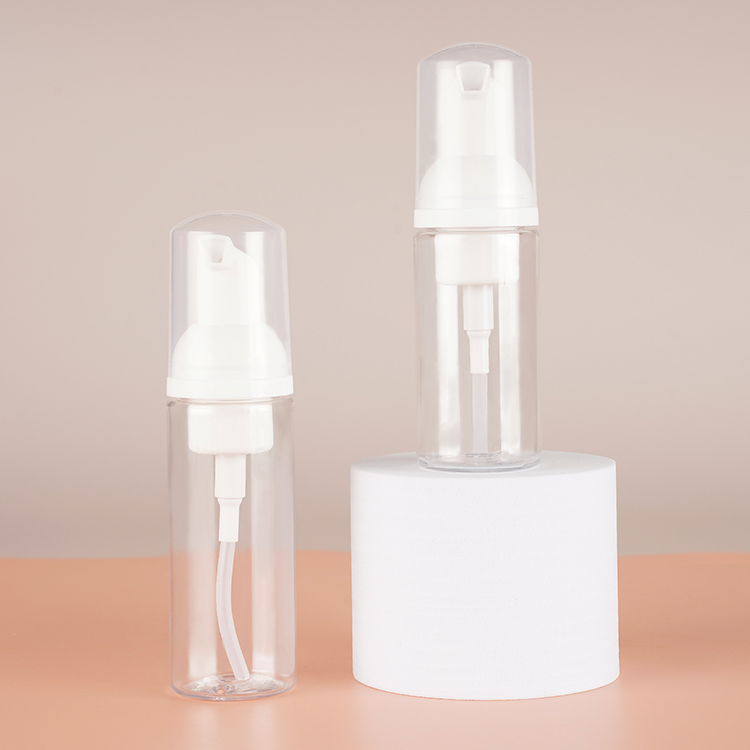
How Do Foam Pump Bottles Work? (The Mechanism Explained)
Foam pump bottles are designed to create foam from liquids like soaps, lotions, and shampoos. The process involves a few simple steps that combine air and liquid to produce a smooth, fluffy foam.
Step-by-Step Process
1. Pressing the Pump Creates Pressure
When you press the pump, it creates pressure within the bottle. This pressure forces the liquid out of the bottle and into the pump mechanism.
2. Liquid Flows Through a Tube to the Pump Mechanism
The liquid is pushed through a small tube connected to the pump. This tube directs the liquid into the foam creation area of the pump.
3. Air is Mixed with Liquid to Form Foam
Inside the pump, air is mixed with the liquid. The pump is designed to force air into the liquid, turning it into foam as it passes through.
4. Foam Dispenses Through the Nozzle
Finally, the foam travels through the nozzle, where it is dispensed in a controlled, consistent manner. This ensures a steady stream of foam each time you use it.
High-End Foam Pump Bottles
Some foam pump bottles are equipped with advanced mechanisms to ensure even better foam consistency. These bottles often feature a mixing chamber designed to control the ratio of air to liquid. By carefully adjusting this ratio, they can deliver a perfect foam every time.
Different Foam Pump Mechanisms
● Traditional Pump vs. Squeeze Bottle Designs
Traditional foam pump bottles use a pressurized pump mechanism to create foam. In contrast, squeeze bottles rely on manual pressure to mix air and liquid. While both create foam, the traditional pump design is more efficient in maintaining consistency.
Foam Dispensing Consistency
Some foam pump bottles are specifically designed to keep the foam-to-liquid ratio steady. This means the foam dispensed is always of the same quality and consistency, reducing waste and improving the overall user experience.
(Visual representation of the foam creation process could be added here)
Key Components of a Foam Pump Bottle and Their Function
Foam pump bottles are made up of several key components, each working together to deliver the perfect foam. Let’s break down how each part contributes to the overall function.
The Bottle Body: Material, Capacity, and Design
The bottle body is usually made from PET (Polyethylene Terephthalate) or HDPE (High-Density Polyethylene). These materials are strong, durable, and recyclable, which is great for both product longevity and the environment. The bottle is designed to be lightweight yet sturdy enough to handle frequent use.
Foam pump bottles come in various sizes, from small 50ml bottles for travel-sized products to larger 500ml versions for commercial use. The design of the bottle may include a simple, sleek look or feature branding and custom colors.
The Pump Mechanism: How It Generates Foam and Its Components
The pump mechanism is the heart of the foam pump bottle. It works by creating pressure that forces the liquid through a tube and into the mixing chamber. Inside, air is introduced and mixed with the liquid, forming foam. The components of the pump, such as the spring, tube, and valve, work together to push the liquid and air, ensuring a smooth, consistent foam output.
The pump is often made from PP (Polypropylene) or ABS (Acrylonitrile Butadiene Styrene). These materials are chosen for their chemical resistance and durability.
The Nozzle: Dispensing the Foam
Once the foam is created, it is dispensed through the nozzle. The nozzle controls the flow of foam, ensuring it is released in the desired amount and consistency. The design of the nozzle can vary depending on the intended use, with some nozzles offering finer control for more luxurious foam and others for more practical use like cleaning products.
In high-end foam pump bottles, the nozzle might be designed to improve foam quality and ensure a more precise flow.
Customization and Design Options for Foam Pump Bottles
Foam pump bottles offer a wide range of customization options, making them an ideal choice for brands looking to stand out. Whether it’s through color, branding, or luxurious finishes, these bottles can be tailored to fit your needs.
Color Options: Different Ways to Achieve Custom Coloring
There are several ways to achieve custom colors for foam pump bottles:
● Raw Material: The color can be integrated directly into the plastic during production, ensuring the bottle has a consistent and durable color.
● Coatings and Paints: Some manufacturers apply color coatings to achieve a specific hue or finish after the bottle is made.
This allows brands to match bottle colors with their product’s branding or create a unique design.
Printing and Labeling: Common Branding Methods
Branding a foam pump bottle is a great way to enhance its appeal. Common methods include:
● Logo Printing: Companies often print logos, taglines, or product information directly onto the bottle surface.
● Labels: Stick-on labels are another common option. They can include detailed product descriptions or promotional designs.
These methods help establish a brand identity and make the product more recognizable on shelves.
Advanced Customization: Embossing, Debossing, and Luxury Finishes
For premium products, advanced customization techniques can elevate the bottle’s design:
● Embossing: This involves creating raised patterns or logos on the surface of the bottle, adding a tactile and sophisticated feel.
● Debossing: The opposite of embossing, debossing creates recessed designs or text, giving the bottle a unique texture.
● Luxury Finishes: Special coatings or finishes, such as metallic or glossy layers, can make the bottle stand out with a high-end look.
These luxury finishes are popular for products in the cosmetics and skincare industries.
Frosted Finish: A More Elegant, High-End Look
A frosted finish gives the foam pump bottle a soft, semi-transparent appearance. This design is often used for premium products to create a more elegant and refined look. It’s a popular choice for high-end cosmetic and skincare brands, as it enhances the visual appeal and conveys a sense of sophistication.
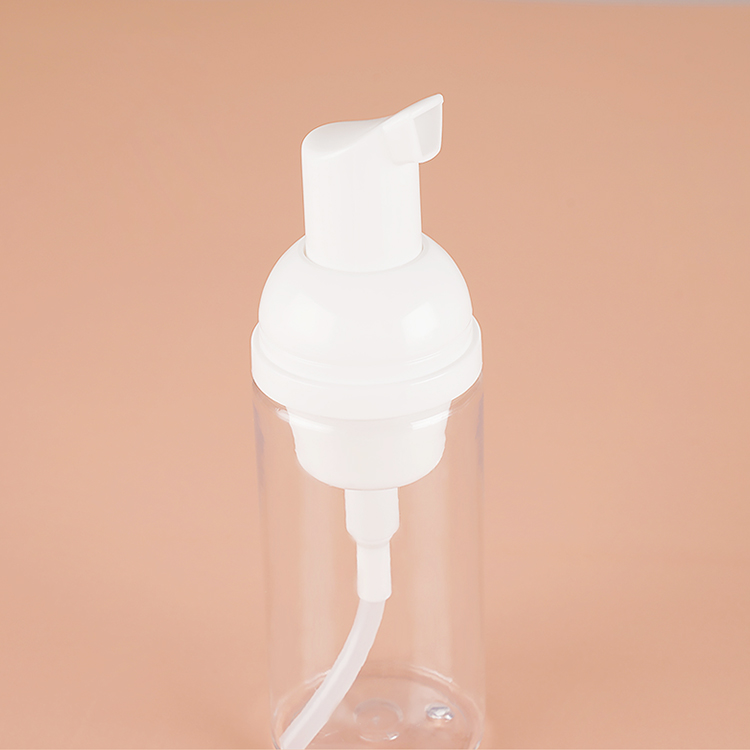
Common Uses and Industries for Foam Pump Bottles
Foam pump bottles are versatile and widely used across many industries. From personal care to niche markets, their ability to dispense controlled amounts of foam makes them ideal for a range of products.
Cosmetic Industry: Face Creams, Lotions, and Other Skincare Products
Foam pump bottles are commonly used in the cosmetic industry for products like face creams, moisturizers, and lotions. The foam ensures a smooth, easy application, making it perfect for skincare routines. It also allows for better control over the amount dispensed, reducing waste.
Household Products: Hand Sanitizers, Soaps, and Cleaning Products
In homes and offices, foam pump bottles are often found in dispensers for hand sanitizers, liquid soaps, and cleaning products. The foam provides a gentle yet effective way to apply these products, especially in high-use environments where cleanliness is important.
Food Industry: Whipped Cream Dispensers and Food-Grade Applications
The food industry uses foam pump bottles for products like whipped cream dispensers. These bottles require food-grade materials to ensure safety and hygiene. Food-grade materials and hygiene standards are critical in preventing contamination, so manufacturers must ensure these bottles meet strict safety regulations.
Niche Markets: Pet Care (Foam-Based Pet Shampoos)
Some foam pump bottles are specifically designed for niche markets, such as pet care. Foam-based pet shampoos are becoming increasingly popular due to their ease of use and gentle application on pets. These bottles provide convenience and control for pet owners, ensuring the right amount of product is dispensed without mess.
Sustainability in Foam Pump Bottles: Recyclable Materials and Eco-Friendly Designs
As consumers become more eco-conscious, many brands are shifting toward sustainable packaging. Foam pump bottles made from recyclable materials are gaining popularity. This includes the use of eco-friendly plastics, such as bioplastics, and innovative designs that reduce environmental impact. Brands are also exploring ways to create refillable and reusable foam pump bottles, further supporting sustainability efforts in packaging.
Advantages of Using Foam Pump Bottles
Foam pump bottles offer several advantages that make them popular in various industries. They are efficient, hygienic, and convenient, making them ideal for both personal and commercial use.
Efficient Dispensing: How Foam Pump Bottles Reduce Wastage
One of the key benefits of foam pump bottles is their ability to dispense a controlled amount of product. This helps reduce waste, ensuring that only the necessary amount is used each time. The foam is dense, allowing users to apply less while achieving the desired effect, whether it's soap, lotion, or shampoo.
Hygienic and User-Friendly: Touchless Dispensing and Ease of Use
Foam pump bottles are incredibly user-friendly and promote hygiene. The touchless design ensures minimal contact with the bottle, reducing the chance of contamination. This feature is particularly important in public places or shared spaces, where cleanliness is a priority. The easy-to-press pumps make it simple for people of all ages to use, ensuring convenience for everyone.
Portability and Convenience: Travel-Sized and Compact Options
Foam pump bottles are available in compact sizes, making them highly portable. Whether you're heading to the gym, traveling, or just need a small amount of product for a short trip, these bottles are perfect for on-the-go use.
Popular Travel Sizes: Common Foam Pump Bottle Capacities for Travel Products (e.g., 50-60ml)
Travel-sized foam pump bottles typically range from 50ml to 60ml. These small but convenient sizes allow users to carry their favorite products without taking up too much space. They're ideal for toiletries and personal care items, ensuring you have just the right amount of product without the bulk.
Pricing, MOQ (Minimum Order Quantity), and Cost Considerations
When considering foam pump bottles for your business, it’s important to understand the pricing structure and the factors that influence costs. Here’s a breakdown of what you need to know.
MOQ for Bulk Orders: Typical Ranges and Flexibility in Order Sizes
The Minimum Order Quantity (MOQ) for foam pump bottles typically ranges from 5000 units for standard bulk orders. However, if you’re looking for customized bottles, the MOQ can be lower, usually between 1000 to 2000 units. This provides flexibility for smaller orders, making it easier to meet your needs without overcommitting to a large stock.
Factors Affecting Pricing: Material Choices, Size, and Customization Options
Several factors influence the price of foam pump bottles:
● Material Choices: PET and HDPE are the most common materials, but more sustainable options like bioplastics can increase costs.
● Size: Larger bottles generally cost more than smaller ones due to the additional material used.
● Customization: Custom colors, logos, coatings, and finishes add to the price. The complexity of the design, such as embossing or debossing, also affects the cost.
Pricing Range: From $0.1 to $0.8 Per Unit
The price for foam pump bottles can vary based on the factors above. On average, prices range from $0.1 to $0.8 per unit. Simpler, smaller bottles with minimal customization will be on the lower end of the spectrum, while larger or highly customized bottles will cost more.
● Lower-Cost Options: Small, simple foam pump bottles without customization are more affordable.
● Higher-End Options: Larger bottles, especially those with custom designs or luxury finishes, cost more.
Volume-Based Discounts: How Suppliers Structure Pricing
Most suppliers offer volume-based discounts, which can significantly lower the unit price if you order in larger quantities. This makes bulk purchasing a cost-effective option for businesses. The more units you order, the less you’ll pay per unit.
However, customization (such as logos, special coatings, or unique colors) might raise the price per unit, even with a large order.
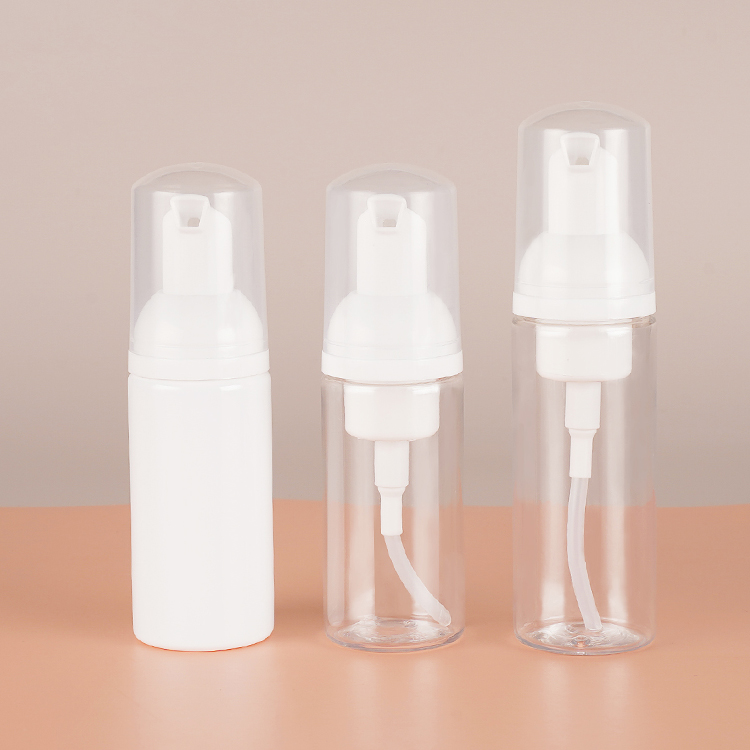
Foam Pump Bottles vs. Other Dispensers
Foam pump bottles are not the only type of dispenser available. Let’s compare them to other common dispensers, like spray and squeeze bottles, to see how they differ in terms of functionality and user experience.
Comparison with Spray Bottles: Differences in Delivery Method and Product Suitability
● Foam Pump Bottles: These bottles create thick, consistent foam by mixing air with liquid. They are ideal for products like hand soaps, face cleansers, and shaving creams, where a dense foam is needed for application.
● Spray Bottles: Spray bottles, on the other hand, emit a fine mist rather than foam. They are better suited for products like cleaning sprays, hair sprays, and air fresheners. Since spray bottles release a fine mist, they are ideal for even distribution but don’t provide the same texture or coverage as foam.
Comparison with Squeeze Bottles: Pros and Cons of Squeeze vs. Pump Action
● Squeeze Bottles: These bottles rely on manual pressure to dispense the product. While they can provide control over the amount used, they often lead to messier applications, especially with thicker liquids. They also require direct contact with the bottle, which can make them less hygienic over time.
● Foam Pump Bottles: Foam pump bottles use a pressurized mechanism to deliver foam with a simple press. They offer a more hygienic, user-friendly experience because there’s no need to touch the bottle’s interior. This reduces contamination risks and ensures a cleaner, more controlled application.
Each dispenser type has its strengths, but foam pump bottles stand out for their convenience, hygiene, and ability to produce consistent foam.
How to Choose the Right Foam Pump Bottle for Your Product
Selecting the right foam pump bottle for your product is crucial for ensuring quality, convenience, and customer satisfaction. Here are key factors to consider when choosing the best bottle for your needs.
Consider Your Product’s Needs: Liquid Thickness, Foam Consistency
Different products require different foam textures. For thicker liquids, you’ll need a pump bottle that can mix air and liquid effectively to create foam. If you’re selling products like shampoos or foaming cleansers, consistency is key, so opt for a bottle that ensures steady foam quality with each pump.
Size and Capacity: What Works Best for Your Product Type
The size of the bottle should match the product's intended use. For travel-sized products or sample offerings, 50-100ml bottles are ideal. Larger products, like bulk cleaning solutions, may require bigger bottles, typically ranging from 200ml to 500ml. The right size ensures ease of use and optimal product distribution.
Material Considerations: Choosing Between PET, HDPE, or Other Plastics
When selecting materials, consider both functionality and sustainability:
● PET (Polyethylene Terephthalate): Clear, strong, and recyclable. Ideal for cosmetic products.
● HDPE (High-Density Polyethylene): Strong, rigid, and resistant to cracking. Best for more durable or heavy-duty uses.
● Alternative Materials: Bioplastics and other eco-friendly options are growing in popularity, offering sustainable alternatives while maintaining durability.
Choosing the right material depends on your product's end-use and the environmental impact you want to make.
Consider the End-Use and Sustainability When Selecting Materials
If sustainability is important for your brand, consider eco-friendly materials like bioplastics or bottles made from recycled plastics. More customers are gravitating toward brands with a focus on sustainable packaging, so this could also boost your brand’s appeal.
Troubleshooting Foam Pump Bottles
Foam pump bottles are durable, but they can still face issues over time. Here’s how to troubleshoot common problems to keep them working effectively.
Common Issues: Clogged Nozzles, Inconsistent Foam
Two of the most common problems with foam pump bottles are clogged nozzles and inconsistent foam. Clogging usually happens when the liquid thickens or residue builds up inside the pump. Inconsistent foam can occur if the pump is not properly mixing air and liquid, resulting in watery or uneven foam.
Regular Maintenance and Cleaning Can Help Prevent Clogging
To avoid these issues, regular cleaning is essential. Make sure to clean the nozzle and pump mechanism every so often, especially if you're using thicker liquids. You can use warm water to rinse the pump, ensuring it’s free of residue that might block the nozzle.
How to Fix Them: Cleaning the Pump, Checking for Damage
● Cleaning the Pump: Remove the pump from the bottle and soak it in warm water. Gently scrub any buildup inside the nozzle and tube.
● Checking for Damage: If the pump is still not dispensing foam properly, inspect it for damage. Sometimes the internal parts of the pump can break, affecting its performance. If the spring or nozzle is damaged, it may need to be replaced.
Ensure the Pump Mechanism is Free of Blockages
Ensure there are no blockages inside the pump, particularly in the tube or nozzle. Use a soft tool like a cotton swab to carefully clear any obstructions.
When to Replace the Bottle: Signs of Wear and Tear or Malfunction
Over time, foam pump bottles may experience wear and tear. The spring mechanism or nozzle can degrade, leading to poor functionality. If you notice reduced foam output or difficulty pressing the pump, it might be time to replace the bottle. Regular inspection can help you identify when a replacement is necessary, ensuring you always have a working dispenser.
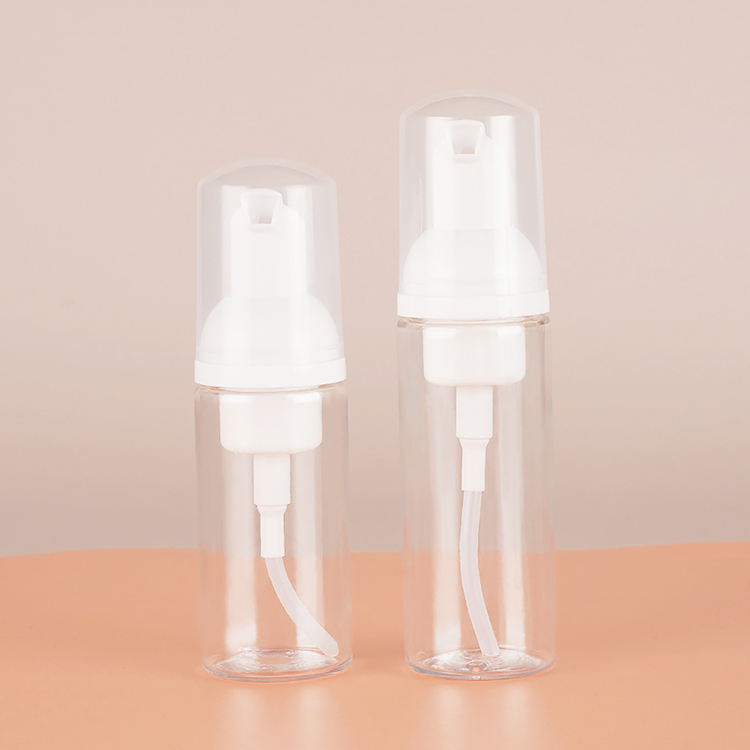
The Future of Foam Pump Bottles
As the demand for foam pump bottles continues to grow, the future holds exciting innovations and trends. Here's a look at what’s to come in the world of foam pump bottles.
Innovations in Design: Advanced Air-Liquid Mixing Chambers
One of the most promising developments is the creation of advanced air-liquid mixing chambers. These chambers are designed to enhance foam quality and improve efficiency. By controlling the ratio of air to liquid more precisely, these chambers can create thicker, more consistent foam while using less product. This innovation not only improves the user experience but also helps reduce product waste.
Sustainability Trends: Eco-Friendly Designs and Materials
Sustainability is becoming a major focus for foam pump bottle manufacturers. More brands are looking for eco-friendly solutions by using biodegradable and recyclable materials. As consumers become more environmentally conscious, the demand for sustainable packaging is rising. Foam pump bottles made from bioplastics or recycled plastics are gaining popularity as companies look to reduce their environmental footprint.
A Growing Trend in Biodegradable or Recyclable Pump Materials
A growing trend is the shift toward biodegradable or recyclable pump materials. As brands strive for sustainability, many are exploring alternatives to traditional plastics. These innovations in packaging not only benefit the environment but also align with consumer expectations for greener products.
Expanding Markets: Growth of Niche Applications (Pet Care, Travel, etc.)
Foam pump bottles are no longer limited to cosmetics. They are increasingly being adopted in niche markets like pet care, travel, and even food packaging. For example, foam-based pet shampoos are gaining popularity due to their gentle, controlled application. Similarly, smaller, travel-sized foam pump bottles are being used for toiletries and personal care items. These bottles cater to specific consumer needs, expanding the market reach of foam pump bottles.
Foam Pump Bottles in Industries Beyond Cosmetics
While foam pump bottles have been a staple in the cosmetic industry, their adoption is growing in other areas. In the food industry, foam dispensers are used for products like whipped cream. In pet care, foam-based shampoos and grooming products are on the rise. As more industries recognize the benefits of foam dispensers, the future of foam pump bottles looks promising.
Conclusion
Foam pump bottles efficiently create consistent foam by mixing air and liquid, offering a controlled dispensing experience. They are versatile, used in industries like cosmetics, household products, and even pet care. Choosing the right foam pump bottle is essential for ensuring product quality, convenience, and sustainability. By considering factors like material, size, and functionality, you can select the perfect bottle for your needs.

